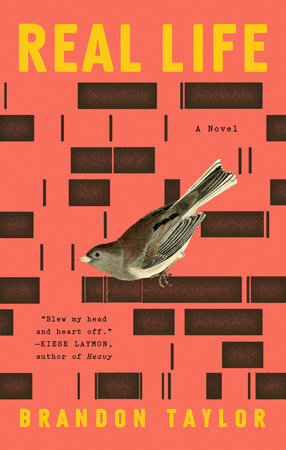REVIEW: Brandon Taylor's Real Life
by Grace Oeth
In a nondescript, humid, Midwestern town, a boy falls in love. We follow him in a vulnerable time and place and ride with him as he experiences what it is like to fall headfirst into love. Brandon Taylor, who wrote this debut novel in a semi-autobiographical sense, introduces us to Wallace, a black, depressed graduate student who works in a microbiology lab as Taylor once did. Sequestered in this town, seemingly in the middle of nowhere, Wallace comes across obstacles, relating to love, his race, and his work which lead him to contemplate the basic languages of life, both on and off the clock.
Wallace is known for having the patience to wait. The other partners in a lab ask him to watch their slides for hours, even days, at a time to log its progress. When Miller, Wallace’s long-time crush, spends the night with him after claiming to “not be into guys,” we get a glimpse of the relationship Wallace was unknowingly waiting for: the sort of anticipation we create for ourselves when being so close to someone you are infatuated with but are unable to be closer to. In the August humidity, the descriptions Taylor provides insert us into the heat that emits from Wallace that makes his sexual advances only seem natural, inevitable. The simmering heat that exists towards the end of summer reflects the feelings one has during the first stages of infatuation, attraction, love; it’s stifling, sticky, and unavoidable. But the genius lies in the contrast between his body and his thoughts, where the raw passion gives way to bland wasteland. Wallace thinks on his physical, passionate relationship, creating a link between mind and body; “The truth of that feeling fit under his skin like a new, uncomfortable self, and he couldn’t get rid of it once he acknowledged it. It was all the same, gray waiting, a fear of not being able to take it all back.”
“The simmering heat that exists towards the end of summer reflects the feelings one has during the first stages of infatuation, attraction, love; it’s stifling, sticky, and unavoidable. ”
As the novel progresses through its choppy timelines, the audience begins to understand why Wallace acts and feels the way he does—almost as if we are working backward while being propelled forward. Taylor stimulates what it is like being in a new relationship having us only understand Wallace through his body, and then slowly delve into the inner workings of his mind. We start with the disconnect and lean into the almost accidental push that led us to propel into the relationship. When Taylor describes Miller and Wallace at first, he shows them “fall[ing] into that chilly silence that comes between two people who ought to be close but who are not because of some early, critical miscalculation.” It’s as if Wallace is viewing his interactions with Miller as an experiment in his lab, and although we anticipate negative results, we are pleasantly surprised with the outcome.
Brandon Taylor does a fantastic job of representing different types of relationships in this novel. They are messy, complex, and break typical sexuality and gender roles. Wallace and Miller belong to a mutual group of friends, and each one seems to have a relationship with one another, beyond platonic feelings. Not in an explicit way, but in a subtle nature, the existence of such a group reflects more of a modern perspective on relationships.
Taylor’s prose, in general, is intuitive, and more often than not, informative. Since Wallace spends most of his time in the biology lab, most of his thoughts are scientific. The reader is introduced and led through explanations about genetics and the laws of nature in which cells must exist. At times the scientific language can be a little overbearing, but once put into context with the rest of Wallace’s life, it becomes more tolerable. We empathize with the workplace gossip, drama, and previous romances he experiences, and the way in which he interacts with people outside of work is put into a more developed context.
This is Taylor’s debut novel, after being published numerous times through journals such as Gay Magazine, The Rumpus, Catapult, The New Yorker, among others, and was nominated for a Pushcart Prize. He is the senior editor of Electric Lit’s Recommended Reading and a staff writer for Lit Hub, providing criticism and reviews on contemporary literature. Taylor also holds multiple fellowships and graduate degrees—including an MFA in Fiction from the Iowa Writers’ Workshop. But on top of all of this, Taylor creates some of the most stunning prose I have seen in a long time. He takes the small observations that are unspoken but commonplace and inserts them into the narration, which is undoubtedly meant to replicate Wallace’s scientific way of thinking. The small ringing of water moving through old pipes, a glass on the brink of overflowing, playing with chipped paint on a picnic table: He is able to make the normal—the relatable—staunchly resonant and almost nostalgic. As if these happenings were beautiful before, and it just took Taylor to tell us that they were all along.
He does the same with love. Humans are prone to know love, or at least know of it, and despite our claims to know what love is, Taylor seeks to make us discover it again. Through Wallace and Miller, we witness something new and fresh, something resembling a more universal feeling of love—but it’s also awkward, and sad, and exploratory. They are learning and we are meant to learn alongside them.
Brandon Taylor’s Real Life releases February 18, 2020 with Riverhead Books. Taylor will be reading at Prairie Lights on February 19th at 7:00 pm.



